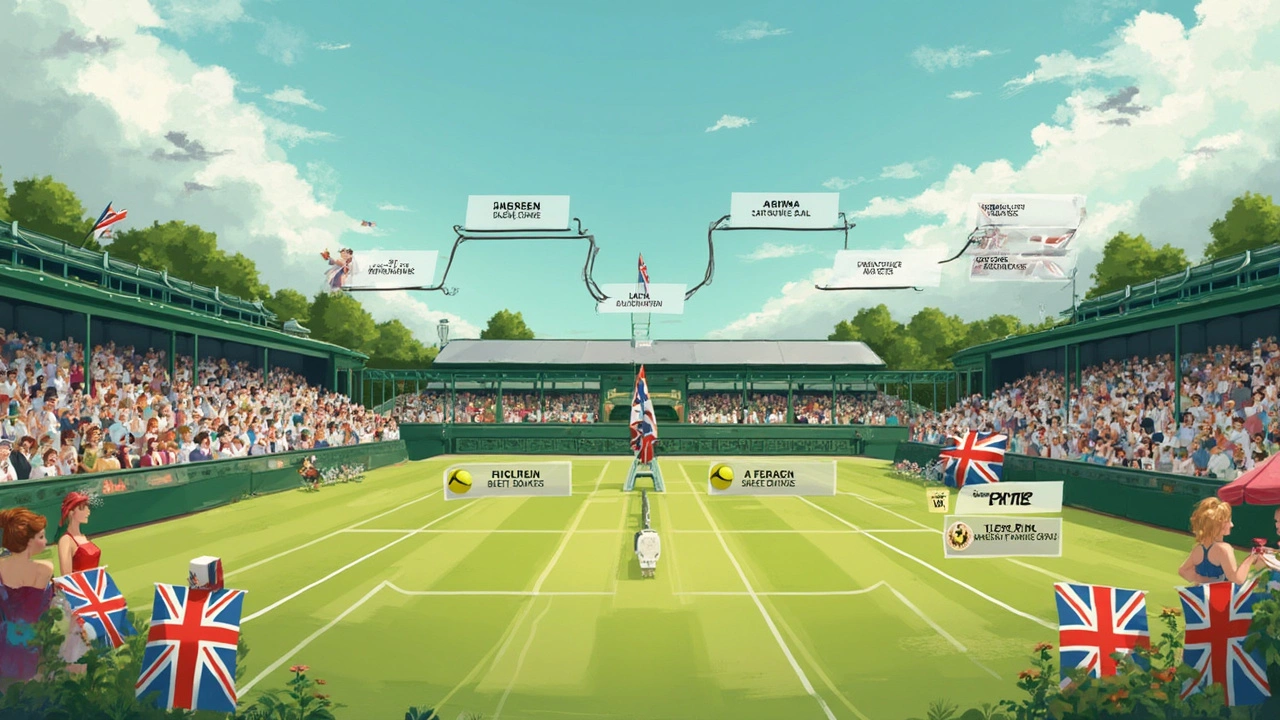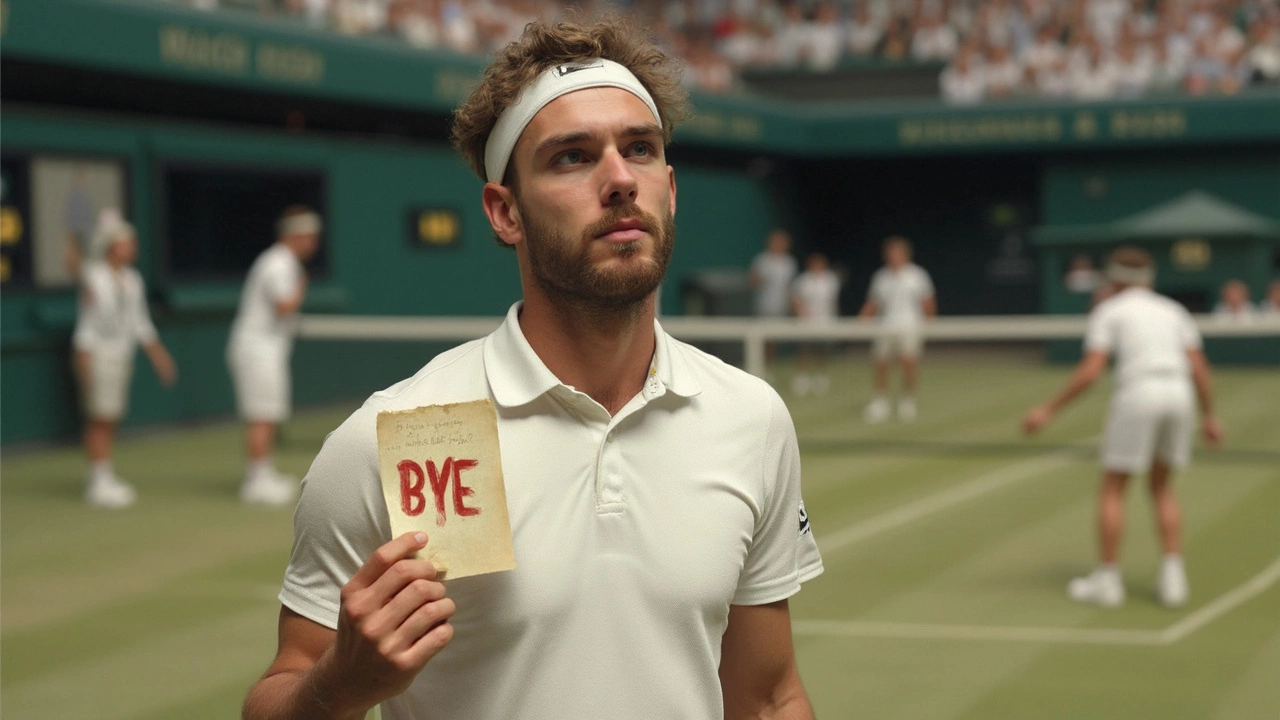Understanding the Bye in Tennis Tournaments
 Apr, 6 2025
Apr, 6 2025
If you've ever watched a tennis tournament and noticed some players casually skipping the first round, you've probably come across what's called a 'bye.' So, what's going on here? A bye is like a free pass, letting a player advance to the next stage of the competition without having to hit a single ball in the initial round. This isn't some random fluke; it's all part of the tournament's design.
A bye is mostly seen in tournaments with an uneven number of competitors, allowing the draw to remain balanced. Think of it as a way to ensure that by the time the competition heats up in later rounds, the number flows just right for head-to-head matchups. It's fascinating how this little-known rule influences competitiveness and strategies. Curious about how this affects the players and why it's implemented? Stick around.
- The Basics of a Bye
- How Byes Impact Players
- Reasons Behind Byes in Tournaments
- Tips for Players Facing a Bye
The Basics of a Bye
So, what exactly is a bye in tennis? Picture this: a player entering a tournament without the need to sweat it out in the first match. In a straightforward sense, a bye offers a player a free pass to the next round. But there's more to it than just skipping a game.
In an ideal world, tennis tournaments would have a neat number of participants, like 16 or 32, making the draw easy to sort. But realistically? Player numbers can be all over the place, so the organizers whip out the bye to keep things fair and square. They're especially common in prestigious tournaments like ATP and WTA tours, where the number of entrants isn't always a nice, even number.
How are these beautifully convenient byes handed out? Well, it isn't just luck. High-ranked players or those with a good track record often snag these slots based on their seeding. Since they're top competitors, letting them rest and skip the chaotic early rounds isn't just thoughtful—it's strategic.
Here's a quick stat to chew on: in a 64-player draw, with only 56 players signed up? The tourney hands out eight byes to fill the gap. It's all about balancing the structure.
Understanding why these byes exist and their method of allocation is crucial. It explains a lot about the dynamics of a tournament and shows why sometimes your favorite player isn't playing on day one. It's not just luck of the draw; it’s part of the game's strategic prowess!
How Byes Impact Players
Getting a bye in tennis might seem like a golden ticket, but it's a mixed bag for players. Sure, it means you skip straight into the next round and get more time to rest. Rest can be crucial, especially in grueling tournaments that take a physical and mental toll. But, unexpectedly, this apparent advantage could twist into a hurdle.
Why is that? It's because missing out on the first match can mean players lose their rhythm. The early rounds often help warm players up, getting them into the groove of the game. Rafael Nadal once said,
"It's strange when you're coming from practice matches into an actual tournament. A bye can sometimes break your rhythm before you've even started."Getting tossed into a more intense match without a warm-up match is not always ideal.
Experienced players might handle this change like pros. They use the extra time for refining strategy and sharpening their skills. Yet for younger or less seasoned players, the absence of match play can trigger nerves. They gotta keep mental focus and stay on top of their game without the typical match day routines to guide them.
Interestingly, the way tennis tournaments use byes isn't symmetrical. The more the tournament progresses, especially for top seeds, the more strategic a bye becomes. It's crucial for those players to maintain their winning edge while avoiding becoming too relaxed during the extra downtime.
In some tourneys, byes are given to top-ranking stars, adding another layer of competition. But it's a two-way street—those lower in the rankings face extra matches, while top-seeded players gain entry straight into later rounds, often on the strength of their prior performances.
| Player Type | Potential Benefit | Potential Drawback |
|---|---|---|
| Top Seed | More rest and prep time | Rustiness in early matches |
| Unseeded | More match experience | Lower energy levels |
Understanding these dynamics can offer some perspective. For fans, it adds another dimension to watch for—how players adapt to these little quirks in the sport. And for players, navigating the pros and cons of a bye effectively can make all the difference in their tournament journey.

Reasons Behind Byes in Tournaments
Alright, let's crack open why those mysterious byes are even a thing in tennis tournaments. It might seem like an odd perk at first, but there's actually some sensible logic behind it. The main reason? It's all about making numbers work, especially when participants aren't evenly divisible by two. Imagine playing a game of musical chairs without one missing chair; someone always ends up without a match, right?
Byes are strategically used to ensure the tournament flows smoothly. Let's say we have 65 players signed up. To make sure each round features a neat head-to-head showdown, 63 components after the bye rounds will seamlessly converge to 32, 16, and further down. It’s like solving a neat puzzle where the pieces just slide perfectly into place.
Another neat perk of byes is they provide top-seeded players with a bit of an unfair advantage, at least on the surface. These players are granted the bye because they're typically ranked higher, rewarding them with an automatic advancement. While some might call it a freebie, it’s actually recognition of their top billing, ensuring fresh players step into the fray later on.
Now here's where byes can get even more captivating from a spectator's point of view. By Offering these top seeds a round off, the tournament creates this nail-biting anticipation as fans wait to see how these top dogs fare once they finally step onto the court. And isn’t that an electrifying aspect to keep us all on the edge of our seats?
Tips for Players Facing a Bye
So, you're a tennis player who just scored a bye in the tournament. Congratulations, but don't just sit back and relax! It's a chance to get an edge on your competitors if you strategize properly.
First up, treat this as more than just an extra day off. Here’s how you can make the most of it:
- Stay in the Zone: Keep your routine as if you had a match. This might mean a practice session to simulate the conditions you'll face when you do play.
- Study Your Opponents: Use the time to watch other players' games, especially those you might face next. Note their strengths and weaknesses. As Roger Federer once said,
"Tennis is a psychological game. Everyone knows the game, but not everyone can keep it together; that’s the skill."
- Stay Active: Don’t let your body cool down. Engage in light physical activity rather than lying around. A little gym time or a leisurely jog can keep the muscles from seizing up.
- Mental Preparation: Visualize the game. Imagine different play scenarios and how you would handle them. This mental rehearsal can be surprisingly effective.
An interesting fact for you: Many top-seeded players often get byes in early tournament rounds. This isn't just a matter of luck; it’s a strategy to have the best fights in the finals. It shields top players from early elimination owing to random draws.
Apart from these tips, remember to use this opportunity to re-energize and get your head in the game. After all, a bye means you’re just one step closer to that big win!